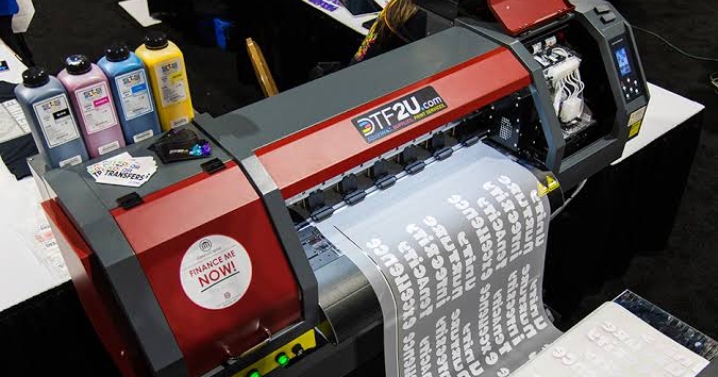In the contemporary landscape of small business operations, the strategic selection of printing technologies plays a pivotal role in determining operational efficiency and product quality. Direct to Film (DTF) printing technology is a viable option for small enterprises.
They can use it to fulfill various printing needs, and it’s cost-effective. Businesses aiming to make informed decisions need to understand the fundamental principles of DTF printing. This understanding should align with their specific requirements and operational scale.
This article navigates the intricate considerations involved in selecting a DTF printer. It emphasizes the significance of a well-informed decision-making process for small businesses. This helps them optimize their printing capabilities. If you are looking for a cost-effective DTF printer, LINKO will help you choose.
Understanding DTF Printing Technology:
Understanding DTF (direct-to-film) printing technology is essential for businesses leveraging this advanced printing method. DTF is a modern approach. It integrates elements from both direct-to-garment (DTG) and direct-to-substrate (DTS) printing. It offers a versatile solution for transferring intricate designs onto various surfaces. Learn more about DTF printers.
At its core, DTF printing involves a systematic process starting with the creation or selection of a digital design. This design is then meticulously printed onto a specialized film using a DTF printer equipped with inks formulated for optimal adhesion. The resulting film serves as a carrier for the intended image.
The subsequent phase of the process entails carefully placing the printed film onto the target substrate, ranging from fabrics to ceramics. A heat press machine is then employed to apply heat and pressure, activating the inks on the film. This controlled heat induces sublimation, causing the inks to adhere permanently to the substrate’s surface.
Several key considerations contribute to the effectiveness of DTF printing. Specialized inks are paramount, ensuring compatibility with the film and substrate. The quality of the film, including transparency and surface tension, directly influences the print outcome. Precise control of heat and pressure during the transfer process is critical for achieving consistent and high-quality prints.
By understanding these fundamental principles, businesses can make informed decisions regarding the adoption and implementation of DTF printing technology. The methodical workflow and integration of specialized components position DTF printing as a reliable and efficient solution for customized prints. It works across diverse applications and substrates.
Analysis of Small Business Printing Needs
Analyzing small business printing needs is a critical step in determining the suitability of direct-to-film (DTF) printing technology for a particular enterprise. Small businesses exhibit diverse requirements. These depend on their industry, scale of operations, and product offerings.
Firstly, the type of materials to be printed upon is a primary consideration. Small businesses may operate in various sectors, each with distinct substrate requirements. Whether textiles, ceramics, or other materials, the compatibility of DTF printing with the intended substrates plays a pivotal role in its viability for a particular business.
Secondly, the production scale is a determining factor. Small businesses often operate with limited quantities and may require a printing solution that offers flexibility in handling both small and medium-sized orders. The ability of DTF printing to cater to varying production scales influences its applicability for businesses with fluctuating demands.
Image quality is another crucial aspect of small business printing needs. Depending on the industry, businesses may have specific standards for print resolution and color accuracy. DTF printing’s capability to deliver high-quality and intricate designs is a key consideration, particularly for enterprises focused on producing visually appealing and customized products.
Moreover, cost-effectiveness is a paramount concern for small businesses. The affordability of DTF printing equipment, consumables, and maintenance contributes to its overall suitability. Small businesses often operate within constrained budgets, and a printing solution that offers a balance between cost and performance is advantageous.
Comparison of DTF Printer Types and Performance
Small businesses need to compare DTF printer types and their performance characteristics. This comparison is pivotal for making an informed decision on printing equipment.
One primary classification is the number of print heads – single-head and multi-head DTF printers. Single-head printers are typically more compact and suitable for smaller-scale operations. They are efficient for businesses with moderate printing needs.
In contrast, multi-head printers are designed for larger production scales, enabling simultaneous printing on multiple areas of the substrate. The choice between these types depends on the desired production capacity and efficiency.
Resolution is a critical performance metric in DTF printing. Single-head printers may offer a higher resolution due to the focused printing area, resulting in finer details. Multi-head printers, while efficient in large-scale production, may have a slightly lower resolution per head. Understanding the specific resolution requirements for the intended applications is crucial in selecting the appropriate printer type.
Production speed is another significant consideration. Single-head printers may excel in intricate designs and smaller batches but might have a slower output rate than multi-head counterparts. Multi-head printers can significantly enhance production speed with their simultaneous printing capabilities. This makes them suitable for businesses with high-volume printing requirements.
Color management is a key aspect of DTF printing performance. Both single-head and multi-head printers offer color capabilities, but the efficiency of color transitions and accuracy can vary. Evaluating the color reproduction capabilities of each printer type is essential, particularly for businesses emphasizing vibrant and precise color in their printed products.
Conclusion
In conclusion, the process of selecting a DTF (Direct to Film) printer for small businesses necessitates a methodical evaluation of several critical factors. The analysis of printing needs includes substrate compatibility, production scale, image quality requirements, and cost considerations. It serves as the foundation for strategic decision-making.
By considering these aspects, with a keen focus on practicality and cost-effectiveness, businesses can navigate the complexities of the selection process. They can also position themselves to leverage the advantages offered by DTF printing in a competitive market landscape.


